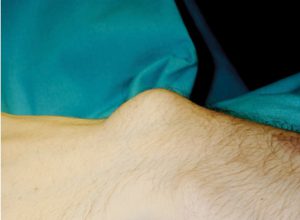Ganglion

What is it?
A ganglion is a harmless swelling, containing a clear jelly like substance. It is commonly found over the back or front of the wrist, the palm side of a finger or at the end joint of a finger (known as a ‘mucous cyst’). A ganglion may fluctuate in size and disappear spontaneously before reforming.
Who gets it and what causes it?
This condition can affect people of all ages but is noted to affect young people between 15 to 40 years of age more often. The ganglion is usually connected to the underlying joint or tendon by a stalk, which provides a route for the fluid to enter it and cause the visible swelling. The actual cause is unknown although various theories have been put forward.
What are the signs and symptoms?
The ganglion may be painful and aesthetically unpleasing. Sometimes when it swells up quite significantly it can cause pressure to surrounding nerves causing symptoms of numbness, tingling and weakness.
What tests will I need?
A consultation, involving a medical history and clinical examination, is usually sufficient to make a diagnosis but an X-ray may be taken to identify any degenerative disease in the joints. An ultrasound or MRI scan may also help confirm the diagnosis.
What is the treatment?
Treatment is not always necessary as ganglions are harmless and can just be observed. Ganglions can recede but it may take many years.
If the ganglion is painful or significantly interfering with your daily life there are a few treatment options.
Needle puncture and aspiration allows drainage of the fluid to reduce the swelling and this can be performed in the clinic. However, recurrence following aspiration is not uncommon. If there is recurrence then surgical treatment may be considered.
What does the surgical treatment involve?
Surgery removes the ganglion and a small part of the associated joint or tendon that is connected to the stalk of the ganglion. By removing the ganglion itself and the source of entry of fluid into the ganglion the recurrence rate is reduced.
Mr. Naqui performs wrist ganglion excision arthroscopically (key hole surgery). This usually requires 3 pinpoint skin incisions. Usually no stitches are required using the keyhole method. If you are interested in having your ganglion removed in this way, please discuss this at your consultation.
Surgery can also be performed in an open manner. In open surgery the surgical scar is usually 3 to 4 cm long. Stitches will be needed to close the wound and a dressing will be applied.
Surgery usually lasts between 30 to 45 minutes and is a day case procedure. Depending on the size and location of the ganglion, it may be done under local, regional or general anaesthetic (see FAQs page).
Mr. Naqui performs ganglion surgery at a number of hospitals around Manchester (see Hospitals page).
What happens after the surgery?
Taking simple painkillers such as paracetamol regularly for the first 2 days after the operation will help to relieve any post-operative pain. Stitches, if used, will be removed at 10-14 days after the operation either at your GP or at the hand clinic. Mr. Naqui and the hand therapist will provide you with specific exercises to perform after the surgery but early hand movements are advised.
When I can return to normal activity ?
If you are a manual worker it is advised to stay off work for around 6 weeks. If you work in an office a period of 2-4 weeks off work is sufficient. A return to driving is usually possible after the sutures, if used, are removed. A return to sports after 6 weeks.
What are the complications of surgery?
There may be pain and stiffness post operatively especially if there is underlying degenerative joint disease. The risks of infection and nerve damage are small. Recurrence of ganglion can occur in approximately 10 to 15% of patients.





